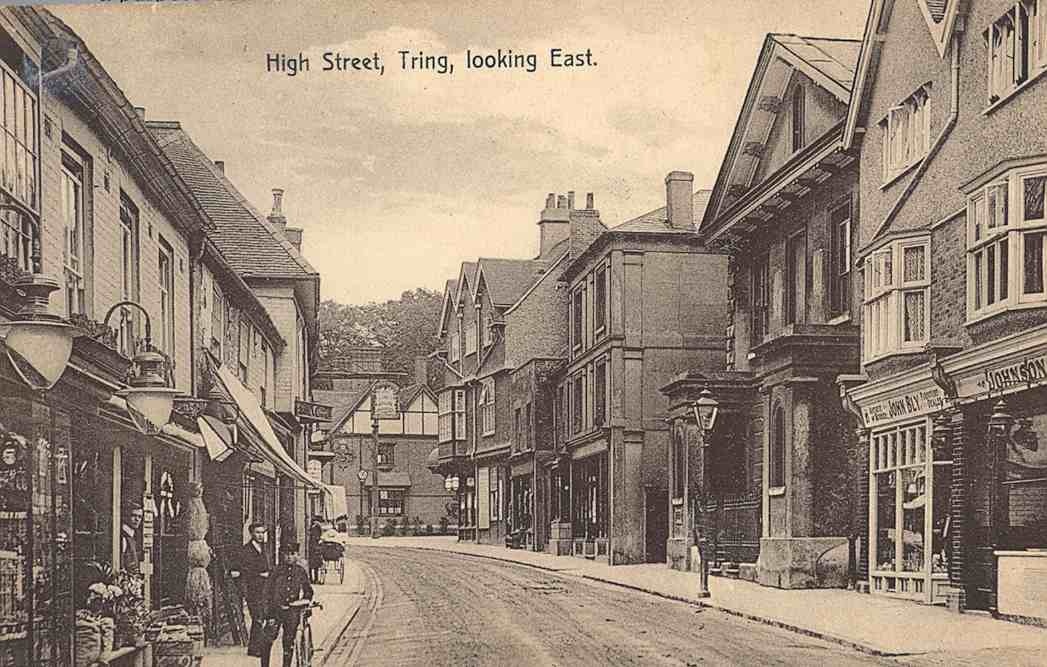
|
Tring High Street in the Edwardian era.
The edifice behind the lamp standard on the right is that of Thomas
Butcher & Sons — also known as The Tring, Aylesbury & Chesham
Bank, and The Tring Old Bank —
its facade projecting a corporate image of solidity, prudence
and honesty, qualities that are no longer quite so evident in
banking. The austere metal railings that now front the
building (shown
below) are a
poor excuse for the ornate ironwork seen here in an age when
corporate and civic pride were more apparent. John Bly’s
antique shop is to the right of the bank — he was the grandfather of
the television antique furniture expert — and what an attractive
facade the shops opposite present, their gas-lights angled to
illuminate the wares within (domestic electric lighting arrived in
Tring in 1926). Of course one didn’t download e-mail in that
era. Having traversed the Victorian Internet —
‘the
telegraph’
— the printed message was delivered by a telegram boy, seen here on
the left holding his bicycle, who then returned to base to arrange
the transmission of any reply. In this horse-powered age
ladies were well advised to raise their skirts when crossing the
road!
Photo: Wendy Austin collection.
――――♦――――
CONTENTS
Background
The Need for a Bank in
Tring
Thomas Butcher &
Sons
The End of the Business
Tring Banknotes
The Chesham
Building Society
The Cholesbury
Parish Room
Acknowledgements
――――♦――――
BACKGROUND: DURING the first half of the 19th Century, England
had many small private banks. These were often set up by local
businessmen — merchants, manufacturers, lawyers, etc. — as a
sideline and to fund their own activities, but they came to play an
important role in developing local economies at a time when the Bank
of England and other London-based banks rarely stirred outside of
the capital. Because they were originally engaged in other
businesses these local bankers were knowledgeable about their
borrowers and the trades in which they were engaged. Many kept
customer accounts, issued their own banknotes and were closely
linked to at least one London bank or ‘agent’ that invested their
customers’ money and settled transactions with other banking firms
(‘interbank clearing’).
But the existence of many small banks empowered to issue their own
banknotes caused serious stability problems, and during the period
1809 to 1830 alone, over 300 of them failed. In 1844, the Bank
Charter Act created the supremacy of the Bank of England and put in
place the process that eventually led to its monopoly of the issue
of banknotes in England and Wales (but not in Scotland, Northern
Ireland, the Isle of Man or the Channel Islands). This
monopoly did not take full effect until 1921, when Lloyds Bank took
over the last private bank of issue, the firm of Fox, Fowler and
Company, which had conducted a banking business at Wellington,
Somerset, since 1787.
THE NEED FOR A BANK IN TRING: the main road through Tring was
turnpiked in 1762 leading to an improved highway with London and the
Midlands, later designated the A41. The
Sparrows Herne Turnpike
was followed in 1799 by the Grand
Junction Canal and then, in 1837, by the
London and Birmingham Railway.
Although there were probably other reasons that cannot now be
identified, improved transport communications must have played some
part in increasing trade with the Metropolis, particularly in
agricultural produce. With growing trade
came an increased population and here Tring’s Silk Mill, opened in
1824, must have made some contribution; in 1840 it employed 40 men,
140 women and 320 children, many from outside the area. In 1840, the condition of Tring
was described thus:
“Modern
Tring is a highly industrious and thriving little town, in which
farmers, manufacturers, and those employed by them, make up the sum
of its inhabitants, which is about 4000. The principal farming
business consists of grazing sheep; much of the neighbouring
pasturage, from the chalky nature of the soil, and the highland
character of the district, being unsuited for other purposes.
The manufactures consist of canvass weaving, a silk mill, and straw
plaiting . . . . Tring has increased its inhabitants so much lately,
that at the present time, owing to the demand for houses, it holds
out a highly alluring and eligible investment for capital, in
buildings suitable for the middle and lower classes of industrious
people.”
London & Birmingham Railway
Guide, by E. C. and W. Osborne (1840).
TRING
(Source: A
Vision of Britain through Time.)
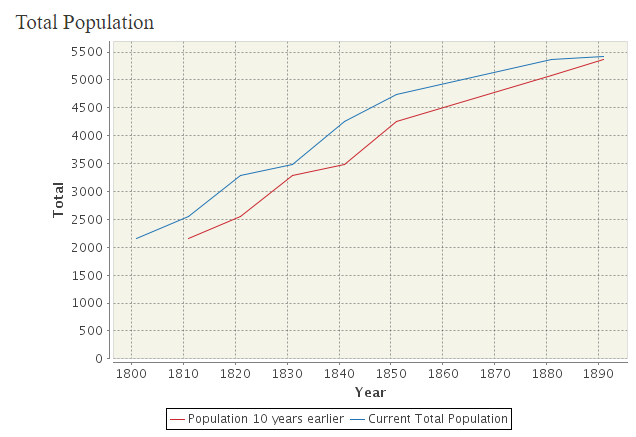
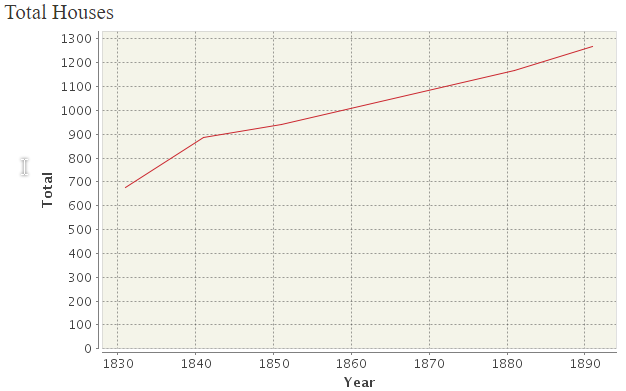
“TRING,
a small town, a parish, and a sub-district, in Berkhampstead
district, Herts. The town stands on Icknield-street, 1¾ mile W. of
the Northwestern railway, and 5 N.W. of Berkhampstead . . . .
consists chiefly of two well built streets; carries on
canvas-weaving, silk-throwing, silk-weaving, brewing,
straw-plaiting, and parchment-making; and has a head post-office, a
railway station with telegraph, a banking office, a market house, a
handsome church (chiefly later English, restored in 1862), five
dissenting chapels, a mechanics’
institute, national schools, a weekly market on Friday, and fairs on
Easter Monday and Old Michaelmas day . . . .
”
Imperial Gazetteer of
England and Wales, 1870-72.
The above extract fails to mention
farming, which the Census analyses show to have been a significant
employer in the area throughout the 19th century. Being a
market town, the farmers − who were an affluent bunch compared with
most folk at the time − came in from outlying areas to
attend Tring’s weekly market and animal auction, and no doubt to
transact business through the bank.
Thus there arose in this
“highly
industrious and thriving little town” a need for banking facilities in an age
before the appearance of modern high street banks.
Nonconformists were prominent among those who set up in business as
bankers, for being barred from a wide range of careers by the
discriminatory legislation of the era they concentrated their
energies on trade and commerce. The Butcher family were
businessmen, dealing in groceries, tea, tallow, seeds and corn.
They were also nonconformists, Strict Baptists, and so extending the
family’s business activities into banking was not so unusual in that
age.
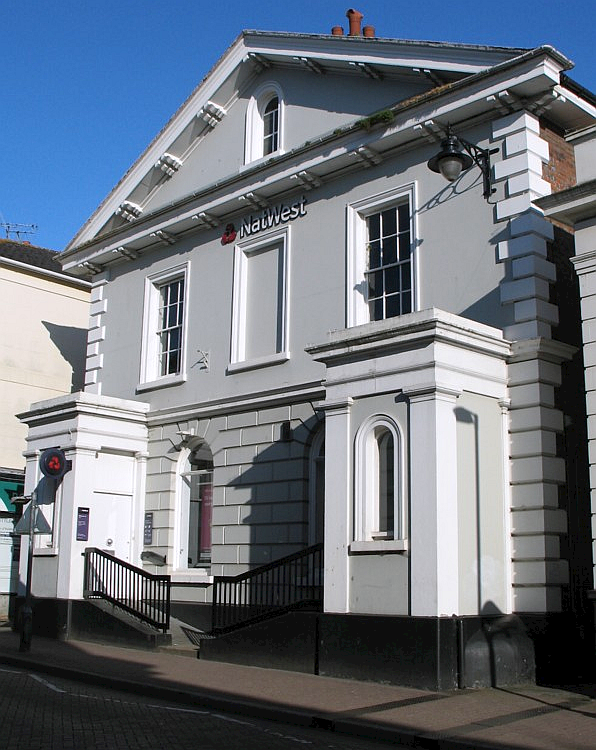
Tring branch, NatWest Bank [1].
THOMAS BUTCHER & SONS: customers entering the National Westminster Bank in Tring High
Street (above, but now closed) might not realise that this was once Butcher’s Bank,
[2]
a private bank and
‘bank
of issue’
established in 1836 by Thomas Butcher in partnership with his son,
Thomas Jnr. [3] Based in Tring, the
bank was also represented (in a makeshift way at first) at Aylesbury
and Chesham on market days. The Bank’s business was mainly
agricultural and it is said that local farmers and merchants used to
accompany the partners when they were conducting banking
business in nearby towns, acting as their escorts.
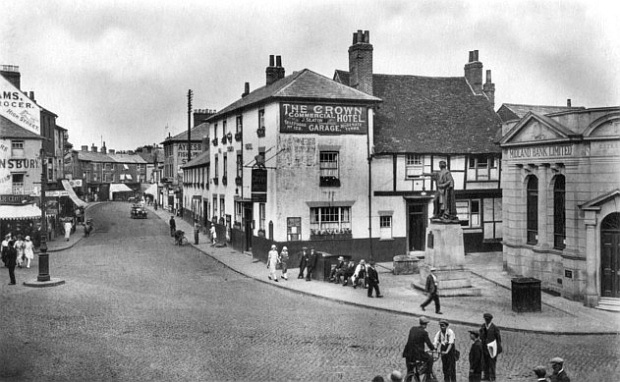
The Crown Hotel, Aylesbury (demolished 1937),
looking down the High Street.
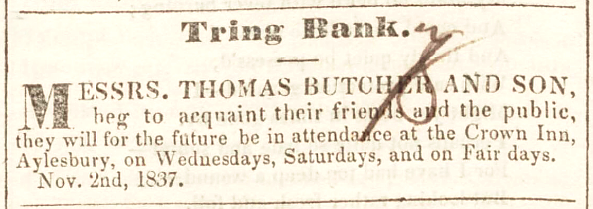
Bucks Herald, 11th November 1837.
Thomas Snr. lived above the bank until his death in 1862 at the age
of 83. Two days later he was followed by his wife, Elizabeth (née
Woodman), their remains being laid to rest in the nearby
Akeman Street Baptist Church burial ground; an imposing stone marks
the spot. Their daughter Lydia drowned in the
Wendover Arm
in 1824, probably aged 16, the newspaper report of the coroner’s
hearing describing her father at that time as a
“grocer,
at Tring.”
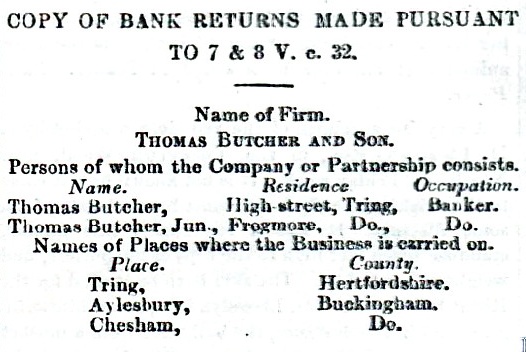
The banking partners in 1845. |
|
In
1826, Thomas Jnr. married Elizabeth Cutler, a lady nine years his
senior, and at some point in their life the couple moved to Frogmore
House, an imposing residence that once stood in Frogmore Street opposite
the Black Horse public house. [4]
Thomas Jnr. eventually took over the bank
from his father and his sons, Frederick and George, became partners
in the business, which then became known as
“Thomas
Butcher & Sons.”
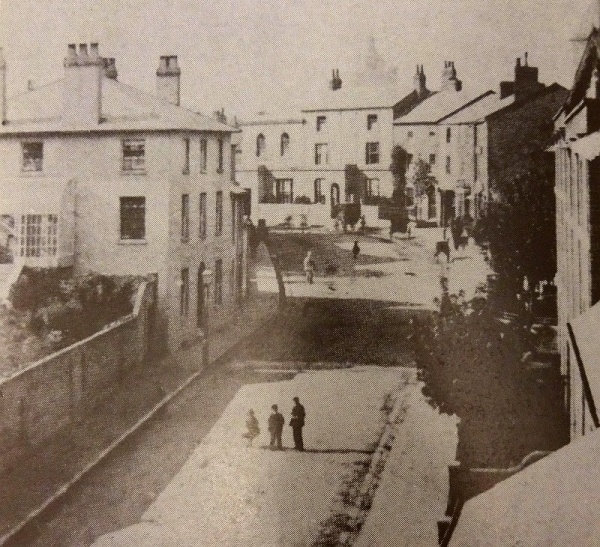
Aylesbury High Street (then called New Road)
C1860
looking towards Butcher’s Bank.
Butcher’s Bank grew steadily under the prudent and close attention
of its partners who established permanent branches in the High
Streets of Aylesbury and Chesham, and an agency in the premises of
Richard Woodman, a tallow chandler in Berkhamsted (perhaps a
coincidence, but Thomas Butcher Snr. married one Elizabeth Woodman);
following the takeover of Butcher’s bank in 1900, Berkhamsted became
a full branch. In his
classical work Lombard Street, Walter Bagehot drew a pen
portrait of the local banker, which from the available evidence
appears to have been true of the
banking members of the Butcher family:
“A
man of known wealth, known integrity, and known ability is largely
entrusted with the money of his neighbours. The confidence is
strictly personal. His neighbours know him, and trust him
because they know him. They see daily his mode of life, and
judge from it that their confidence is deserved. Accordingly,
the bankers who for a long series of years passed successfully this
strict and continuous investigation, became very wealthy and
powerful . . . . The calling is hereditary; the credit of the bank
descends from father to son; this inherited wealth soon brings
inherited refinement.”
Lombard Street: A
Description of the Money Market, Walter
Bagehot (1873).
Thomas Jnr. died in 1871:
“The
late Mr. Thomas Butcher, banker of Tring, who died on the 5th of the
present month, at the age of 65 years, was an inhabitant of the
county, and was well known and highly esteemed. Mr Butcher was an
ardent and consistent Liberal, and did much to advance the Liberal
cause in the district in which he resided. He was a Nonconformist,
and was greatly respected for his excellent qualities by all who
knew him, whether Churchmen or Dissenters.”
Hertford Mercury,
29th April 1871.
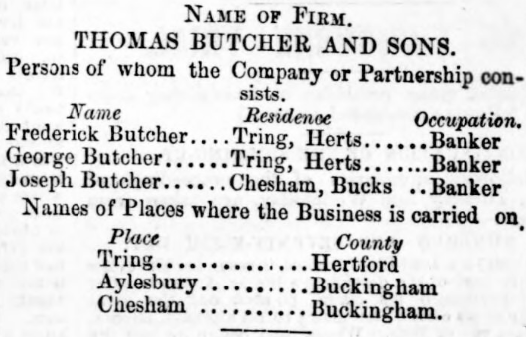
The banking partners in 1874.
|
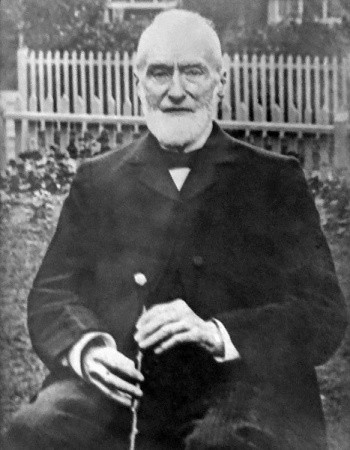 |
|
Frederick Butcher (1827-1919) |
Following Thomas Jnr.’s death, Joseph joined his brothers Frederick
and George as a partner in the business. Frederick retired
from the
firm in February 1891 and ceased to be a partner in the business.
Frederick followed his grandfather and
father as a deacon of Akeman
Street Strict & Particular Baptist Church in Tring. He
was a wealthy man, using his
money to help the Baptists ― especially
the Strict Baptists ― with chapel projects in the Chilterns.
He also served as Chairman of the Tring Urban District Council from
its creation in 1895 until 1901; on
the death of Queen Victoria it fell to Frederick to express the
Council’s condolences:
“THE DEATH OF THE
QUEEN.
― Before proceeding to the
ordinary business, the Chairman [Councillor F. Butcher]
moved the following resolution:
―
‘That
this Council record their deep sorrow upon the death of her Most
Gracious Majesty Queen Victoria, and respectfully beg to offer to
his Majesty the King an expression of their sympathy with his
Majesty and the Royal Family in their great bereavement.’
It is not necessary, nor was that the occasion, to dilate upon the
character of the late Sovereign. A capable and judicious
ruler, a loving wife and parent, a sympathetic and tender Queen, she
would be greatly missed by her Ministers of State, by her children
and relations, and also by her subjects. ―
Mr. J. G. Williams formally seconded, and the resolution was passed
in silence, all standing.”
Bucks Herald, 16th February 1901.
The Bank
continued under the direction of George and Joseph until 1896, when
Joseph died. George’s sons, Francis Joseph and Walter, then became
partners and, together with George, directed the
firm during its
final years,
George, Francis Joseph, and Walter running the branches at
Aylesbury, Chesham and Tring respectively.
George Butcher was by now head of the firm. Born in Tring in
1835, he appears in the 1851 Census living with his parents at
Frogmore House, his occupation being described as Bank Clerk.
The 1881 Census shows him and his wife Fanny living above the Bank
in Tring with their two sons, Francis Joseph and Walter, who were
employed as Bank Clerks. Fanny died in 1898:
“We
regret to have to record that Mrs George Butcher (Fanny Elizabeth)
passed away at her residence The Bank, Tring on Thursday afternoon.
Great sympathy is felt with Mr Butcher who is so well known in the
district as head of the Banking House, Thomas Butcher & Sons of
Tring, Aylesbury & Chesham, and as Chairman of the Aylesbury Bench
of Magistrates.”
Bucks Herald, 26th February
1898.
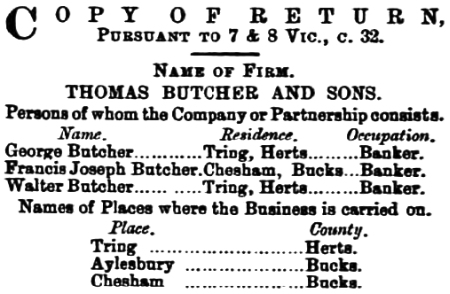
The banking partners in 1900.
George followed his wife on the 29th August, 1901, aged
67 years:
“Mr.
Butcher was one of the best known and most respected of the
residents of this district. Owing to his long connection with
the banking firm known for so many years as Thomas Butcher and Sons,
and with so many of the commercial and benevolent institutions of
this town, he was probably quite as well know, and spent almost as
much of his time at Aylesbury as in his native town of Tring.
Endowed with quite exceptional business capacity and insight, sound
judgement, and a long and extensive experience in all financial
matters − scrupulously just and honourable in all his dealings,
small or great, with his fellow men − he not only filled a leading
position in the Bank identified with his family with conspicuous
ability and success, but his advice and counsel were often eagerly
sought, not only by clients, but by many others who had no business
claim upon him; and advice and counsel were not seldom supplemented
by substantial assistance where the circumstances called for it.
Few men will be more missed in this district.
It is impossible at such short
notice to recapitulate all the positions which he filled with so
much honour to himself and advantage to the public. He was a
J.P. for the County and Chairman of the Aylesbury Bench, a member of
the Monthly Board of the Royal Bucks Hospital, a trustee and
Treasurer of the Aylesbury British Schools, Chairman of the
Chiltern Hills Water Company,
the Aylesbury and
Tring Gas Companies, and the Aylesbury Market
Company. He was associated with Messrs. R. Dickens, H. Wyatt, and W.
W. Walker − all now deceased −
and other gentlemen in the
successful operations of the Bucks Land and Building Company.
Mr. Butcher belonged to an old and staunch Nonconformist family, but
his religious sympathies were ever of a catholic and tolerant
character. In politics he was a Liberal Unionist, and a loyal
supporter of the late Baron F. Rothschild, taking the chair at most
of his political meetings in Aylesbury. He married a daughter
of the late Mr. J. H. Marshall of Aylesbury, who died a few years
ago, and leaves two sons, both of whom are engaged in the business
of the Bank, which is now merged in that of Messrs. Prescott, Dimsdale, Cave, Tugwell and Co. (Ltd.), of London, previously its
London agents.”
The Bucks Herald, 31st August 1901.
“The will of the
late Mr. George Butcher has just been proved at £100,700 15s 3d.
The executors of the will, which is dated Aug. 4, 1901, are the
deceased’s
two sons and late partners, Mr. Francis Joseph Butcher, of Chesham
(bank director), and Mr. Walter Butcher, of Tring, (bank director)
to whom the testator left in equal shares the whole of his property.”
The Bucks Herald, 2nd November 1901.
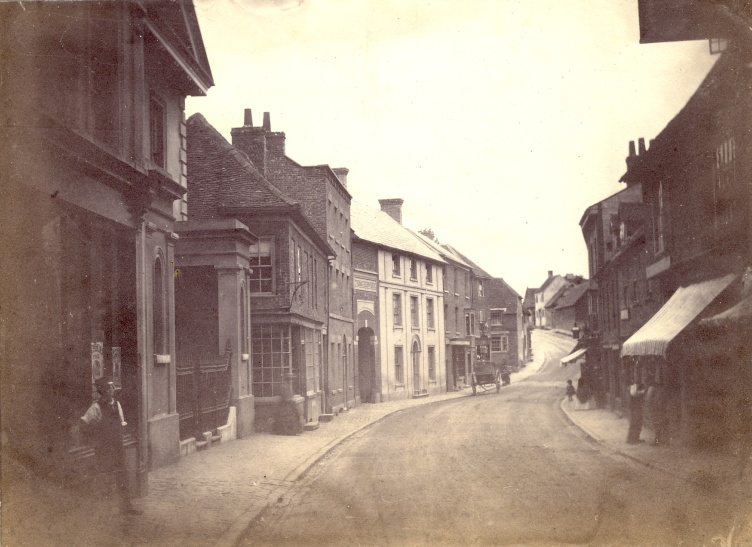
A view along Tring High Street, c. 1870.
Butcher’s Bank,
marked by the iron railings, is just visible on the left.
Photo: Wendy Austin collection.
As part of its business the Bank probably advanced loans on the
security of property, which, in the final years of the 19th century
may have been the reason why it acquired a windmill. The
windmill in question was
Goldfield Mill, now a private dwelling at
the junction of Miswell Lane and Icknield Way, Tring. Herbert
Wright, son of the last miller, left a short account of his early
life in which he recalls that Thomas Butcher & Sons owned the mill
worked by his father James. The details of this acquisition
are not known, but it seems possible that the Bank acquired
Goldfield Mill as foreclosure on an outstanding loan following the
bankruptcy of its then owner, Thomas Liddington, in December 1888.
THE END OF THE BUSINESS:
Thomas Butcher & Sons was eventually taken over by its London
agents, the bankers Prescott, Dimsdale, Cave, Tugwell & Co (est.
1766):
“Bank
amalgamations, and the conversion of private business undertakings
into limited liability companies, are events of such common
occurrence nowadays as to cause but little notice or comment.
An operation of the first mentioned nature which has been announced
this week will, however, certainly excite considerable interest in
the district. The banking business of Messrs. Thomas Butcher
and Sons has been amalgamated with that of Messrs. Prescott,
Dimsdale, Cave, Tugwell, and Co. (Limited), with whom, as their
London agents, Messrs. Butcher have been closely connected for more
than sixty years. Although, doubtless, a good many people will
regret to see a certain amount of change introduced into the status
of an old and trusted institution, the new arrangement is sure to
meet with the full approval of the customers of Messrs. Butcher, as
no alteration will be made in the management. Small private
banks are rapidly becoming things of the past, and that this local
bank would one day be amalgamated with a larger undertaking was
regarded by not a few persons as practically inevitable. The
change, indeed, may be welcomed in many quarters.”
The Bucks Herald,
24th March 1900.
Following the takeover the three partners continued as local
directors at their respective branches.
An entry reading
“Bank,
Premises, Furniture, and Purchase Account Thomas Butcher and Sons”
appears under
“Assets”
in Prescott’s
balance sheet, as at the 31st December, 1901. It shows a
valuation of £229,627 3s 5d, presumably the sum that Prescotts paid
for Butcher’s business. In 1903, Prescott, Dimsdale, Cave, Tugwell &
Co became Prescott’s Bank, and in the same year
amalgamated with
Union of London & Smiths Bank (est.
1839). Following
further acquisitions and mergers, the firm amalgamated with the National
Provincial Bank in 1918, which in turn merged with the Westminster
Bank to form the National Westminster Bank in 1970.
TRING BANKNOTES:
According to surviving records, Thomas Butcher & Sons issued
bank notes between 1836 and 1900, the known denominations being of £5 and £10.
However, the Bank Charter Act, 1844 (7 & 8 Vict. c. 32), gave the
Bank of England the monopoly to issue new banknotes, and issuing
banks were required to withdraw their existing notes in the event of
their being the subject of a takeover. Thus, as provincial
banking companies merged to form larger banks, they lost their right
to issue notes and the English private banknote eventually
disappeared.
|
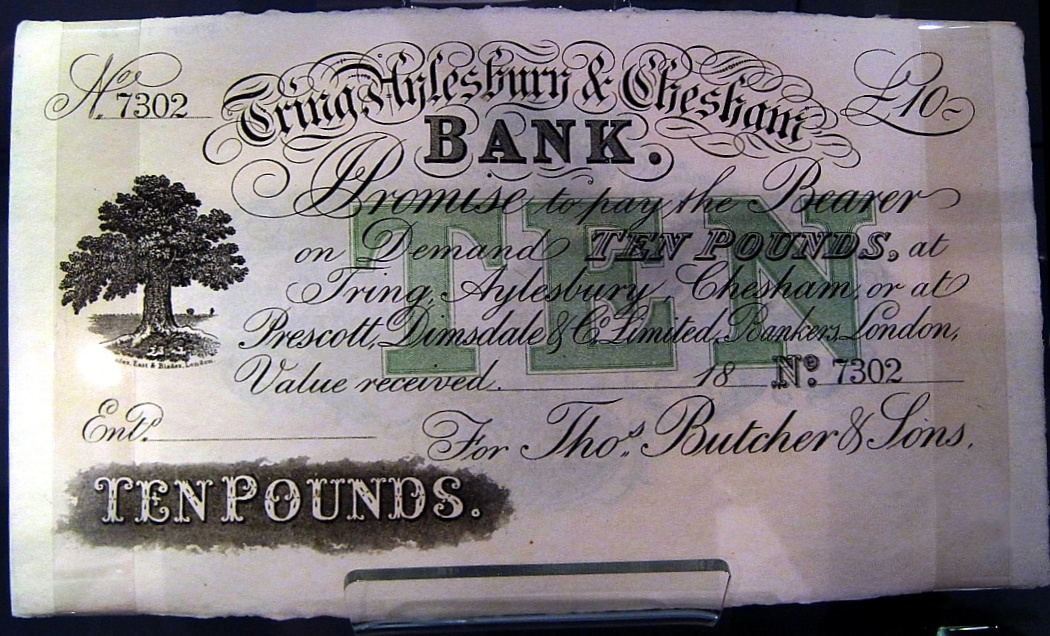
|
A £10 banknote issued by Thomas Butcher &
Sons.
In 1844, the total value of banknotes issued by Thomas Butcher &
Sons was £13,531. A 19th century ten pound note issued
by the
“Tring, Aylesbury and Chesham Bank”,
unsigned and undated, was
recently offered for sale at £250; but what was signing and dating?
Banknotes were originally hand-written,
although from about 1725 onwards they were partially printed, but
cashiers still had to sign each note and make them payable to
someone. The ‘£’ sign and first digit were printed, but other
numerals were added by hand, as were the name of the payee, the
cashier’s signature, the date and the number. Although early
banknotes could be for uneven amounts, most were for round sums.
By 1855, banknotes had become entirely machine printed and payable
to ‘the bearer’.
THE CHESHAM BUILDING SOCIETY: although Butcher’s Bank is long gone, a financial organisation that grew
out of a suggestion by Thomas Butcher Jnr. continued in operation
until 2010; indeed, at the time of its closure it was the oldest
building society in the world. Not the Halifax or the Abbey
National, as one might expect, but the Chesham. When founded
in 1845 it was not the earliest building society, but older
societies − the first known being Ketley’s Building Society, named
after the landlord of the Golden Cross Inn in Birmingham, where it
held its meetings − had gone out of business or had merged with
others.
At that time the Society was formed, Chesham’s inhabitants lived mostly in and around
the centre of the town, which supported long-established industries based on
local products; the beech woods yielded wood for the manufacture of
shovels, brooms, spoons and chairs; the river Chess provided water
to power mills, as it
had since Saxon times; there were tanneries, breweries, paper-making
and other trades; straw-plaiting was a cottage industry for women
and girls; boots and shoes makers supplied
the London market, and bricks and tiles were other staple products. As
industries developed, they employed a greater proportion of the
local population who began looking for a secure way to invest their
savings. Thomas Butcher Jnr., who lived in Chesham,
suggested to a group of influential businessmen that a building
society could operate successfully in the town.
A society was formed. Thomas Butcher Jnr. and his son Frederick
were among its trustees, while one of the early directors was one Arthur
Liberty, whose business later grew into the internationally famous
department store off Regent Street. All of gave their services free;
in the Society’s early days, only the Secretary received a salary.
The Society had its head office in Chesham and eventually had
branches in Little Chalfont and Aylesbury and an agency in Tring.
But by February 2010 the effects of ultra-low interest rates forced
it to surrender its independence. With bank rate at 0.5% it
was unable to make a profit on its lending and borrowing, and this
pressure on its finances forced it into the red in 2009. As a
result the Society’s members agreed to a rescue by the the UK’s fourth
largest building society, the Skipton.
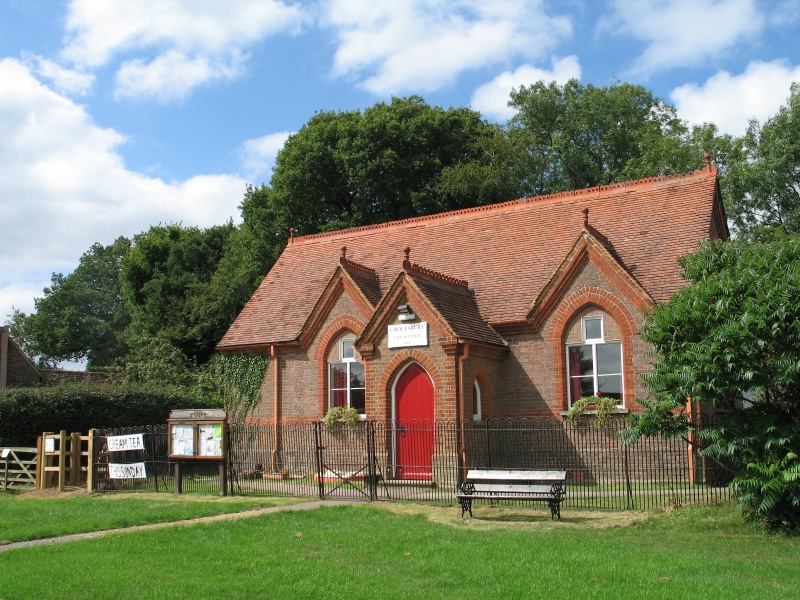
The Village Hall, Cholesbury.
THE CHOLESBURY PARISH ROOM:
A remaining legacy of the Butcher family is the Village Hall at Cholesbury near Tring. Built in 1895 on land given to the
people of Cholesbury by Frederick Butcher (grandson of Thomas Snr.,
the Bank’s founder), it is an attractive Victorian building situated at
the Buckland Common end of Cholesbury. Originally just a
“parish
room”
it was soon taken over by the Men’s Club, which charged 1p a week
membership and did its best to exclude rowdies from the neighbouring
villages.
――――♦――――
FOOTNOTES
1. The history of the building now occupied by
NatWest Bank on Tring High Street is unclear, nevertheless it is unlikely to date
from 1836 and the formation of Butcher’s Bank; it is probably
much later. Writing C1900, local historian Arthur MacDonald
Brown claims that Thomas Butcher & Son originally set up their
banking business in the Counting House (now No. 9 High Street,
then called Market Street). The Counting House we see
today is a late 19th century alteration of an older building ―
probably that used by Thomas Butcher & Son ― carried out for Lord
Rothschild by William Huckvale. |
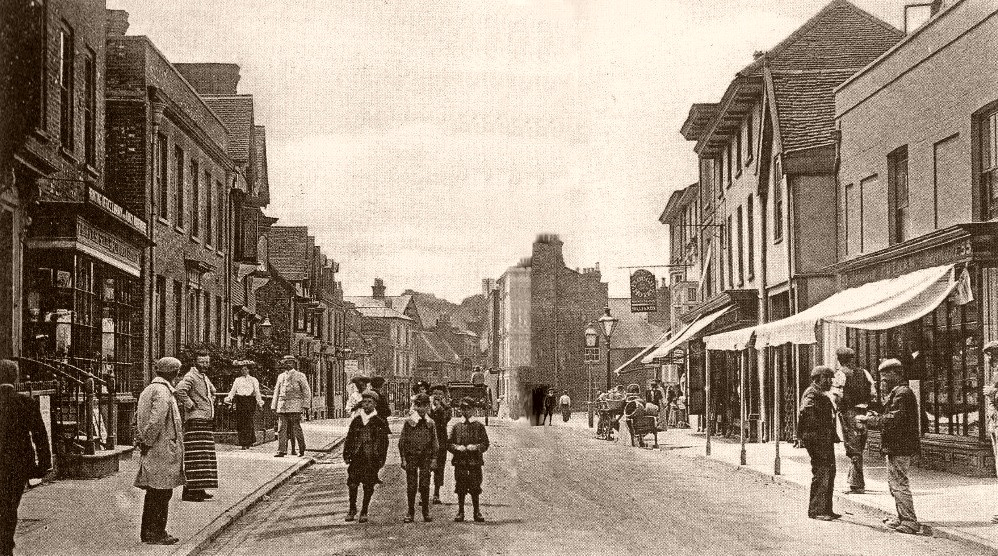
The Counting House (second building from the left)
C1900, before it received Huckvale’s Tudoresque recladding ―
the two adjacent buildings to its right have already been
done.
|
MacDonald Brown
goes on to say that:
“Tring Bank [i.e. the present NatWest premises]
was built by Thomas Butcher Jnr. on the site of two old shops with
half doors and steps up to them. Over one of those doors Mr
Rogers, cooper, was usually to be seen reposing with arms akimbo and
pipe in mouth, the ideal British attitude of repose and
proprietorship. Very few of the doings of Tring escaped the
observation of this sentry, the coaches changing horses at the
Bell
opposite being a source of never failing interest. The other
shop was occupied by Mr. Tomkins, baker.”
MacDonald Brown’s note suggests that the bank was built from
new, perhaps following Thomas Snr.’s
death in 1862 (banking returns show that he remained senior partner
until that year). However, in their
description of the NatWest building, Historic England consider it
possible that it is an 18th century structure re-fronted in the 19th
century, but re-fronting is not clearly evident . . . .
NATIONAL WESTMINSTER BANK WITH ATTACHED HOUSE, OUTBUILDINGS, WALLS
OF WALLED GARDEN, AND GATEWAY ON SOUTH.
TRING HIGH STREET SP 9211 (South side) 11/73 No. 20 - (National
Westminster Bank) with attached house, outbuildings, walls of walled
garden, and gateway on South GV II Bank with house and walled garden
attached. Early C19 bank fronting possibly C18 house and
walled garden. Painted stucco bank, red brick house
and garden, slate roofs. A 2-storeys and attic bank with
architectural elaboration on N gable-end to street. Plinth and
V-rusticated ground floor, moulded cornice as string returned as
member of entablature below blocking course of 2 small square
projecting pilastered kiosks with entrances in facing sides and
small round-headed front window to each with moulded surround.
2 round-arched windows between kiosks. 1st floor of smooth
stucco lined as ashlar with rusticated quoins and moulded surround
to 3 square-headed openings, central one blind, outer ones with 6/6
panes recessed sashes. Wide eaves soffit with paired brackets
with similar verges to form pediment with small round-headed window
in tympanum. House at rear faces S into garden and 2-storeys E
wing has rounded corner to yard to E. 3m approx wall all round
garden with pilaster buttresses on outside above plinth dying into
wall at half height. S gateway has 2 taller square piers with
stone caps and coping between. Ogee stone arch with pointed
top and small moulded corbel. Brick jambs with stone inset for
hinge pin. Battened wooden door.
2. The bank was also known as Tring Old Bank; the Tring, Aylesbury and Chesham Bank;
the Bank of Tring; and, in Aylesbury, the Aylesbury Bank.
3. The following was received from the Archivist, NatWest
Bank:
“Orbell
and Turton in ‘British Banking’ cite Thomas Butcher & Sons as being
established in 1836. This is supported by the note registers
we have for Tring branch which are dated from 1/1/1836.”
4.
Frogmore House . . . .
“In
the centre of Tring stood a large house, Frogmore, which took
its name from the street in which it was situated, and was the home
of the owners of the town’s private bank. Thomas Butcher
established what is now the NatWest in the High Street in the 1830s,
and at first lived over the premises and enjoyed the large garden
area behind. When his son inherited the estate, he took
advantage of the natural springs at the bottom of Frogmore Street to
include several water features in the overall garden layout.
At the turn of the century the head gardener was Joseph Reeve, a
local man who had been born in the now-vanished hamlet of Lower
Dunsley. He was also responsible for overseeing the
maintenance of the large garden at the rear of Butcher’s Bank in the
High Street. Joseph lived with his family in one of a pair of
pretty cottages opposite The Black Horse. He was
expected to supply choice examples of fruit from the orchard, and
vegetables from the kitchen garden to exhibit in the local
horticultural show [the Tring Agricultural Show].
Along with other head gardeners in the area, he enjoyed considerable
success. However, their names never appeared on the winner’s
certificate or challenge cup, as it was always their employers who
received the credit. In any case, all Joseph Reeve’s
efforts were swept away in 1956 when Frogmore, the grounds,
the water gardens, the gardener’s
cottage, and 18 acres of land were sold for redevelopment.”
Tring Gardens Then and Now,
Wendy Austin (2006). |
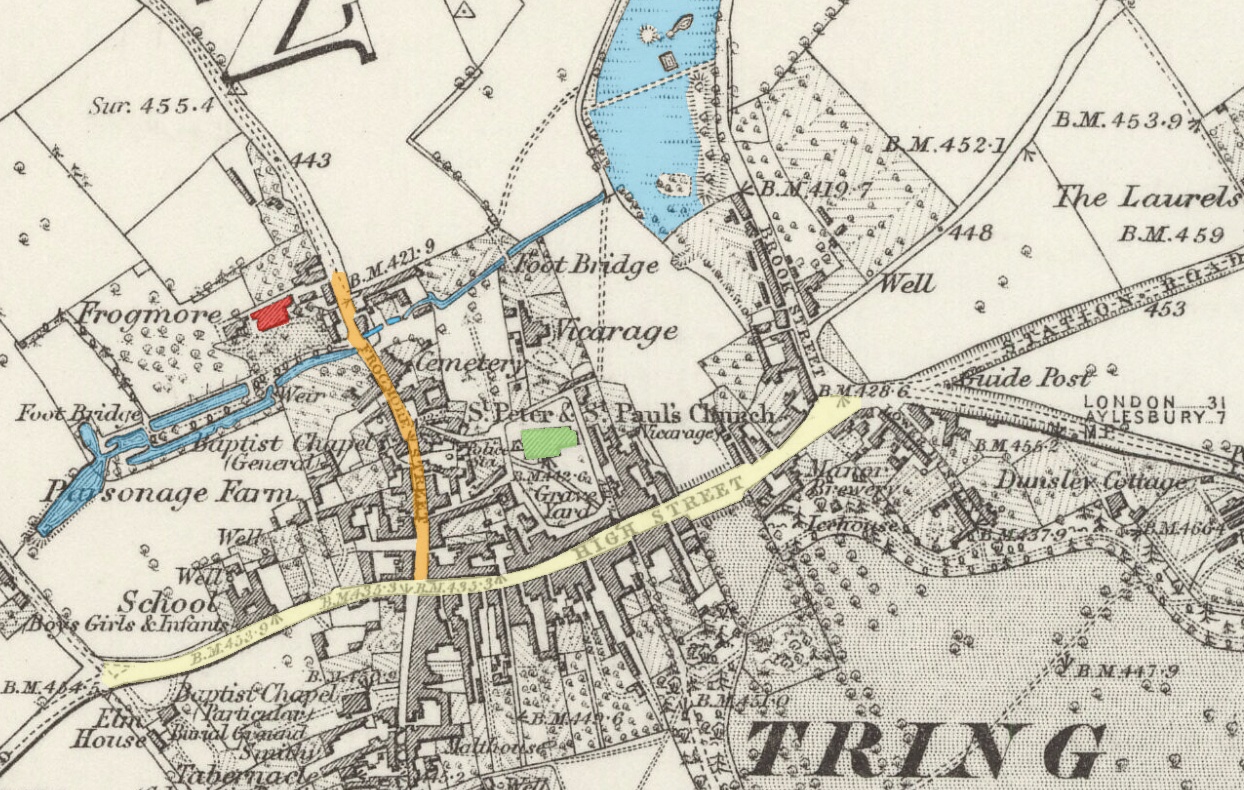
Tring in 1877: key . . . .
Frogmore House, red; Water Gardens and stream to Silk
Mill Pond, blue; Parish Church, green; High Street, yellow; Frogmore Street,
orange.
|
The last owner of Frogmore was Arthur Butcher, the youngest
son of Frederick and Ann, who died on the 23rd September, 1955, at
the age of 91. Arthur studied law at Cambridge but never
practiced. He was a first class batsman, captained Tring Park
Cricket Club and played for Hertfordshire County and the M.C.C.
(1902-1905; batting style, right-hand; bowling style, right-arm
slow). He was also a good golfer and shot. A notice in
the Bucks Herald (4th November 1955) states:
“Mr
Butcher’s
Will − Mr Butcher of Frogmore Street and Butchers Bank left
£452,782. Mr Butcher inherited his money from the family
Banking business. Butcher’s
Bank started in Tring early in the last century with later
businesses in Berkhamsted and Aylesbury. It was taken
over by the Union of London & Smiths Bank, which afterwards was
absorbed by the National Provincial.”
Following Arthur’s
death in 1955 his estate was bought at auction by the
Luton builders H. C. Janes & Co for £9,000. Frogmore was
demolished to make way for a new estate, which included Friars
Walk
and Deans Furlong.
――――♦――――
ACKNOWLEDGMENTS
I’m grateful to the Archivist of The Royal Bank of Scotland, of
which Butcher’s bank is a constituent, for providing much of the
information about the Bank and its notes in
circulation, to the Secretary of the former Chesham Building Society
for information about the Society’s early years, and to my friend
and sometime co-author, Wendy Austin,
for her advice and the use of photographs from her collection.
Ian Petticrew
December, 2016.
――――♦――――

<>
|
|